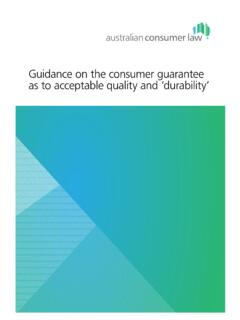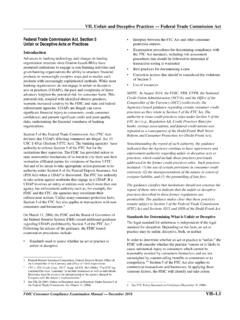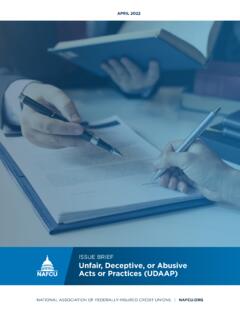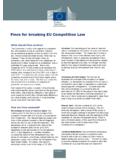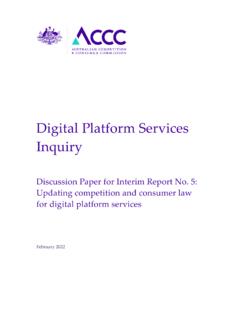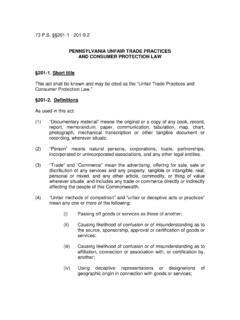Transcription of The Australian Consumer Law
1 July 2013 The Australian Consumer LawA framework overview Commonwealth of Australia 2013 ISBN 978-0-642-74877-5 This publication is available for your use under a Creative Commons Attribution Australia licence, with the exception of the Commonwealth Coat of Arms, the Treasury logo, photographs, images, signatures. The full licence terms are available from Use of Treasury material under a Creative Commons Attribution Australia licence requires you to attribute the work (but not in any way that suggests that the Treasury endorses you or your use of the work). Treasury material used as supplied . Provided you have not modified or transformed Treasury material in any way including, for example, by changing the Treasury text; calculating percentage changes; graphing or charting data; or deriving new statistics from published Treasury statistics then Treasury prefers the following attribution: Source: The Australian Government the Treasury.
2 Derivative material If you have modified or transformed Treasury material, or derived new material from those of the Treasury in any way, then Treasury prefers the following attribution: Based on the Australian Government the Treasury data. Use of the Coat of Arms The terms under which the Coat of Arms can be used are set out on the It s an Honour website (see ) Other Uses Inquiries regarding this licence and any other use of this document are welcome at: Manager Communications The Treasury Langton Crescent Parkes ACT 2600 Email: Australian Consumer Law A framework overview v FOREWORD The Australian Consumer Law (ACL) is a key part of the deregulatory reforms of the Council of Australian Governments (COAG) to deliver a seamless national economy.
3 The ACL replaced provisions spread across at least 20 Commonwealth, state and territory Consumer laws with one law. The ACL is the culmination of a process of cooperation between the Commonwealth Government and the states and territories through the Ministerial Council on Consumer Affairs (now the Legislative and Governance Forum on Consumer Affairs, or CAF). It draws on the conclusions of the 2008 Productivity Commission (PC) Review of Australia s Consumer Policy Framework, best practice in existing state and territory laws, and consultations undertaken during 2009-10. Under the National Partnership Agreement to Deliver a Seamless National Economy, the Commonwealth, State and Territory governments agreed to complete the legislative process to implement the ACL by 31 December 2010 and that it would commence in all jurisdictions on 1 January 2011.
4 The ACL was implemented through enactment of the Trade Practices Amendment ( Australian Consumer Law) Act (No. 1) 2010 and the Trade Practices Amendment ( Australian Consumer Law) Act (No 2) 2010. The full text of the ACL is set out in Schedule 2 to the competition and Consumer Act 2010 (CCA). This overview of the ACL has been prepared as a practical aid to understanding the ACL. Separate guides covering the provisions in the ACL are available for businesses, as well as fact sheets for consumers at Australian Consumer Law A framework overview vii CONTENTS FOREWORD .. V GLOSSARY OF TERMS .. IX THE ROLE OF THIS XI THE Australian Consumer LAW .. 1 General 2 Unfair Practices .. 2 Consumer Transactions .. 3 The Product Safety Law.
5 4 Offences .. 6 Enforcement and Remedies .. 7 THE DEVELOPMENT OF THE ACL .. 8 THE DRAFTING OF THE ACL .. 9 THE ACL AS AN APPLICATION LAW .. 10 SUPPORTING THE IMPLEMENTATION OF THE ACL .. 12 Governance arrangements .. 12 Key ACL resources .. 14 AMENDING THE ACL .. 15 INDUSTRY-SPECIFIC Consumer LAWS .. 16 The Australian Consumer Law A framework overview ix GLOSSARY OF TERMS ACCC Australian competition and Consumer Commission ACL Australian Consumer Law ASIC Australian Securities and Investments Commission ASIC Act Australian Securities and Investments Commission Act 2001 BRCWG Business Regulation and competition Working Group CAANZ Consumer Affairs Australia New Zealand CAF Legislative and Governance Forum on Consumer Affairs CCA competition and Consumer Act 2010 COAG Council of Australian Governments IGA Intergovernmental Agreement for the Australian Consumer Law.
6 Signed by members of the Council of Australian Governments on 2 July 2009. LG Forum Legislative and Governance Forum for Corporations PC Productivity Commission TPA Trade Practices Act 1974 The Australian Consumer Law A framework overview xi THE ROLE OF THIS GUIDE This guide is intended to provide a broad overview of the ACL. In The Australian Consumer Law: A guide to provisions you can find a more detailed explanation of the provisions of the ACL. For a comprehensive explanation of the ACL, please refer to the text of the ACL, which forms Schedule 2 to the CCA (available at ), or the Explanatory Memorandums and Supplementary Explanatory Memorandums that are associated with the Acts which implemented the ACL (available at ).
7 The Australian Consumer Law A framework overview 1 THE Australian Consumer LAW The ACL is a single, national law, which applies in the same way nationally and in each State and Territory. It is the principal Consumer protection law in Australia. Under the ACL, consumers have the same protections and expectations about business conduct wherever they are in Australia. Similarly, businesses have the same obligations and responsibilities wherever they operate in Australia. The ACL: replaced a range of existing Commonwealth, state and territory Consumer laws and clarified understanding of the law for Australian consumers and businesses; is a schedule to the competition and Consumer Act 2010; is applied as a law of the Commonwealth.
8 The ACL is also applied as a law of its jurisdiction in each State and Territory so that the same provisions apply across Australia; is enforced by all Australian courts and tribunals, including the courts and tribunals of the States and Territories; is administered by the Australian competition and Consumer Commission (ACCC) and each State and Territory s Consumer law agency; and reflects similar protections in the Australian Securities and Investments Commission Act 2001 (ASIC Act) in respect of financial products and services. What does the ACL cover? The ACL includes: core Consumer protection provisions prohibiting misleading or deceptive conduct, unconscionable conduct and unfair terms in standard form Consumer contracts; specific protections against certain defined unfair practices, including particular instances of misleading or deceptive conduct, pyramid selling, unsolicited supplies of goods and services, component pricing and the provision of bills and receipts; regulation of certain aspects of Consumer transactions, including: a system of statutory Consumer guarantees for Consumer goods and business goods valued below $40,000; a national legal framework for unsolicited selling, including door-to-door trading and telephone sales.
9 A national law for Consumer product safety; and robust enforcement and Consumer redress provisions. The Australian Consumer Law A framework overview 2 GENERAL PROTECTIONS Chapter 2 of the ACL establishes the general standards of business conduct. Misleading or deceptive conduct The ACL prohibits misleading or deceptive conduct in trade or commerce. It is unlawful for a business to make statements in trade or commerce that are misleading or deceptive, or which are likely to mislead or deceive. Failing to disclose relevant information, promises, opinions and predictions can also be misleading or deceptive. Unconscionable conduct The ACL includes provisions prohibiting persons from engaging in unconscionable conduct towards consumers or businesses.
10 In 2010, the Government amended the ACL to provide that a court may have regard to a number of matters in determining whether there has been unconscionable conduct in relation to the supply or acquisition of goods or services in trade or commerce. These matters include, but are not limited to, the relative strengths of the bargaining positions of the parties, the use of undue influence, pressure or unfair tactics by the stronger party, the willingness of the stronger party to negotiate the terms and conditions of a contract for supply, and the extent to which each party acted in good faith. Unfair contract terms The ACL provides that unfair terms in standard form Consumer contracts are void. A Consumer contract is one for the supply of goods or services, or for the sale or grant of an interest in land, to an individual for personal, domestic or household use or consumption.

